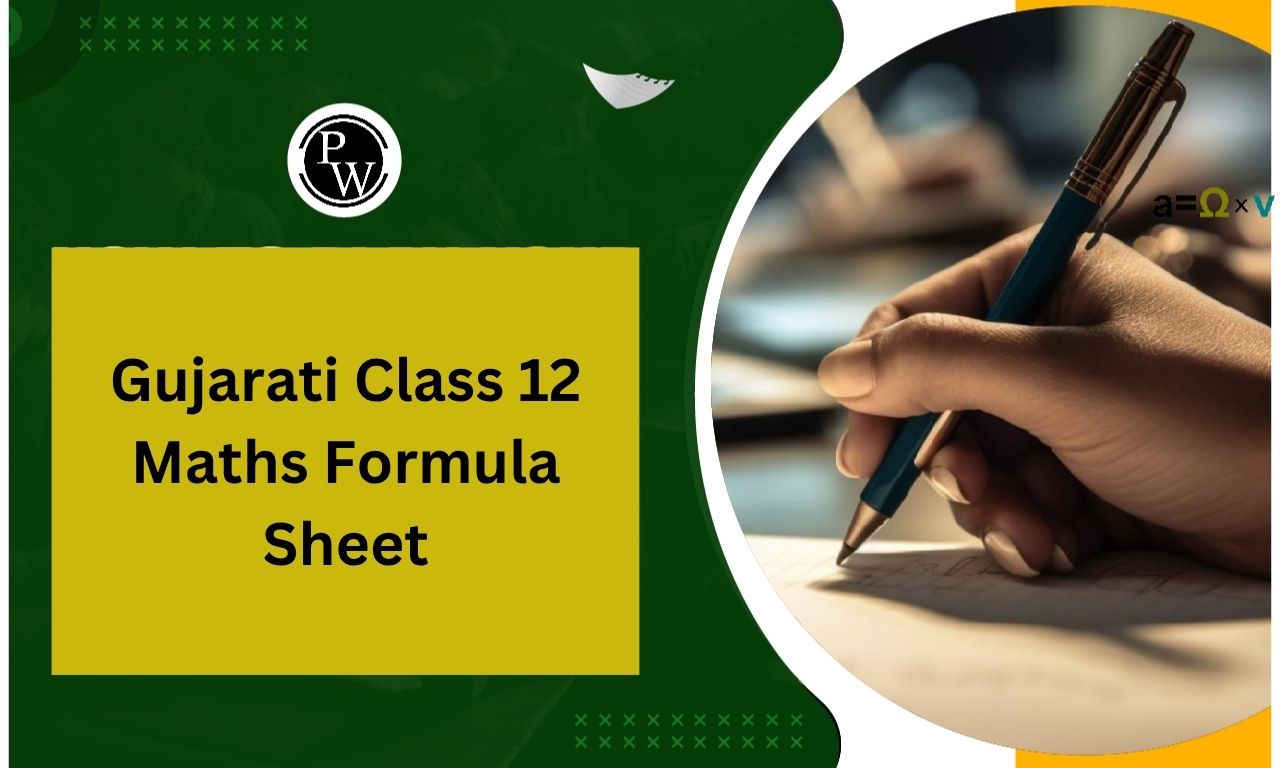

Gujarat Board Class 12th Chemistry Syllabus 2025-26 : For students preparing for the Gujarat Board Class 12th exams, mastering Chemistry is crucial. The Gujarat Board Class 12th Chemistry Syllabus is thoughtfully designed to build a strong foundation in chemical concepts and principles.
This syllabus covers a wide range of topics, from basic atomic structure to complex chemical reactions, ensuring students gain a thorough understanding of the subject. With a clear focus on both theory and practical knowledge, the syllabus prepares students not only for their board exams but also for future academic pursuits in science. Understanding this syllabus is key to achieving success in the 12th board exams.Gujarat Board Class 12th Exam Overview
The Gujarat Board Class 12th Chemistry Syllabus Overview provides a clear structure of the topics and concepts students need to study. Detailed information is provided in the table below.| Exam Name | Gujarat Class 12th Exam |
|---|---|
| Conducting Body | The Gujarat Secondary and Higher Secondary Education Board |
| Category | Syllabus |
| Frequency of Conduction | Once in an Academic Year |
| Mode of Exam | Offline |
| Exam Duration | 3 Hours |
| Question Paper Marks | 100 Marks (Theory Marks + Internal Assessments) |
| Negative Marking | No Negative Marking |
| Official Website | gseb.org |
Gujarat Board Class 12th Chemistry Syllabus 2025-26
The Gujarat Board Class 12th Chemistry Syllabus outlines essential topics and concepts that are crucial for students’ understanding. Refer to the table below for detailed information on the syllabus.| Gujarat Board Class 12th Chemistry Syllabus 2025-26 | |
| SL No. | UNITS |
| 1 | Some Basic Concepts of Chemistry |
| 2 | Structure of Atom |
| 3 | Classification of Elements and Periodicity in Properties |
| 4 | Chemical Bonding and Molecular Structure |
| 5 | States of Matter: Gases and Liquids |
| 6 | Gases and Liquids |
| 7 | Chemical Thermodynamics |
| 8 | Equilibrium |
| 9 | Redox Reactions |
| 10 | Hydrogen |
| 11 | S-Block Elements |
| 12 | Some p-Block Elements |
| 13 | Organic Chemistry |
| 14 | Some Basic Principles and Techniques |
| 15 | Hydrocarbons |
Gujarat Board Class 12th Chemistry Chapter Wise Weightage
The Gujarat Board Class 12th Chemistry Syllabus Important Topics highlight key areas that students should focus on to excel in their exams. Detailed information is provided in the table below.| Gujarat Board Class 12th Chemistry Chapter Wise Weightage | ||
|---|---|---|
| Chapter No. | Chapter Name | Important Topics |
| 1 | The Solid State | General Characteristics of Solid State, Amorphous and Crystalline Solids, Classification of Crystalline Solids, Crystal Lattices and Unit Cells, Number of Atoms in a Unit Cell, Close-Packed Structures and Packing Efficiency, Calculations Involving Unit Cell Dimensions, Imperfections in Solids, Electrical Properties of Solids, Magnetic Properties of Solids |
| 2 | Solutions | Types of Solutions, Methods of Expressing Concentration of Solutions, Solubility, Vapour Pressure of Liquid Solutions, Raoult’s Law, Ideal and Non-ideal Solutions, Colligative Properties, Elevation in the Boiling Point of the Solvent, Depression in the Freezing Point of the Solvent, Osmosis and Osmotic Pressure of the Solution, Van’t Hoff’s Factor |
| 3 | Electrochemistry | Electrochemical Cells, Galvanic Cells, Electrode Potential and Standard Electrode Potential, Nernst Equation, Relationship between Electrode Potential, Gibb’s Energy and Equilibrium Constant, Electrolytic and Metallic Conduction, Conductance in Electrolytic Solutions, Kohlrausch’s Law and its Application, Electrolytic Cells and Electrolysis, Batteries, Fuel Cells, Corrosion and its Prevention |
| 4 | Chemical Kinetics | Rate of a Chemical Reaction, Factors Affecting the Rate of a Reaction, The Rate Law and Rate Constant, Order of a Reaction, The Molecularity of a Reaction, Integrated Rate Law for Zero and First Order Reactions, Pseudo First Order Reactions, Temperature Dependence of the Rate of a Reaction, Collision Theory of Chemical Reactions |
Gujarat Board Class 12th Chemistry Chapter Wise Weightage
The Gujarat Board Class 12th Chemistry Chapter Wise Weightage provides insights into how marks are distributed across various chapters, helping students prioritize their studies. Detailed information is provided in the table below.|
Gujarat Board Class 12th Chemistry Chapter Wise Weightage |
|
| Chapter Name | Marks |
| The Solid State | 7 |
| Solutions | 7 |
| Electrochemistry | 8 |
| Chemical Kinetics | 8 |
| Surface Chemistry | 6 |
| General Principles and Processes of Isolation of Elements | 5 |
| The p-block Elements | 7 |
| The d- and f- block elements | 6 |
| Coordination Compounds | 8 |
| Haloalkanes and Haloarenes | 6 |
| Alcohols, Phenols and Ethers | 6 |
| Aldehydes, Ketones and Carboxylic Acids | 6 |
| Amines | 6 |
| Biomolecules | 6 |
| Polymers | 5 |
| Chemistry in Everyday Life | 3 |
Gujarat Board Class 12th Chemistry Syllabus 2025-26 PDF Download
For students aiming to excel in their board exams, having the Gujarat Board Class 12th Chemistry Syllabus PDF is essential. This PDF offers a detailed breakdown of all the topics and chapters that students need to cover. It includes important areas like chemical reactions, periodic classification, and more. Having the syllabus in a downloadable format allows students to plan their studies efficiently and ensures that they don’t miss out on any crucial topics. The download link is provided below for easy access.Steps to Prepare Gujarat Board Class 12th Chemistry Syllabus for 2025-26
- Focus on understanding the fundamental concepts such as atomic structure, bonding, and periodic classification. These form the base for more complex topics.
- Spend more time on chapters that carry more marks in the exam, such as Chemical Reactions and Equations, and Carbon Compounds. These are key areas that can boost your overall score.
- Practice numerical problems in areas like mole concept and stoichiometry. Regular practice will help you solve these questions quickly and accurately during the exam.
- For complex topics like chemical bonding and organic chemistry, use diagrams, flowcharts, and mind maps to simplify and retain information.
- Schedule regular revision sessions, especially for memorization-heavy topics like the periodic table and chemical equations. This will ensure that you retain information over the long term.
- Solving past years’ question papers will familiarize you with the exam pattern and help you identify areas where you need more practice.
- While it’s important to cover all topics, avoid spending too much time on easier sections. Allocate more time to difficult or high-weightage chapters.
- Regularly check for any updates or changes to the syllabus to ensure that your preparation is aligned with the latest guidelines.
Gujarat Board Class 12th Chemistry Syllabus FAQs
Are there any changes in the Gujarat Board Class 12th Chemistry Syllabus for 2025-26 compared to previous years?
It's important to check for any updates or changes in the syllabus each year. Students should consult the latest syllabus provided by the Gujarat Board to ensure they are studying the correct material.
What are the practicals included in the Gujarat Board Class 12th Chemistry Syllabus 2025-26?
The syllabus includes essential practicals such as volumetric analysis, qualitative analysis of organic and inorganic compounds, and experiments related to chemical kinetics and electrochemistry.
How much weightage is given to Organic Chemistry in the Gujarat Board Class 12th Chemistry exam?
Organic Chemistry typically holds significant weightage in the exam, with a considerable number of questions focusing on topics like hydrocarbons, alcohols, phenols, and carbonyl compounds.
What are some high-scoring topics in the Gujarat Board Class 12th Chemistry Syllabus?
High-scoring topics often include Chemical Kinetics, Electrochemistry, and Solutions. Mastery of these areas, along with regular practice, can significantly boost your overall score in the Chemistry exam.
Talk to a counsellorHave doubts? Our support team will be happy to assist you!

Check out these Related Articles
Free Learning Resources
PW Books
Notes (Class 10-12)
PW Study Materials
Notes (Class 6-9)
Ncert Solutions
Govt Exams
Class 6th to 12th Online Courses
Govt Job Exams Courses
UPSC Coaching
Defence Exam Coaching
Gate Exam Coaching
Other Exams
Know about Physics Wallah
Physics Wallah is an Indian edtech platform that provides accessible & comprehensive learning experiences to students from Class 6th to postgraduate level. We also provide extensive NCERT solutions, sample paper, NEET, JEE Mains, BITSAT previous year papers & more such resources to students. Physics Wallah also caters to over 3.5 million registered students and over 78 lakh+ Youtube subscribers with 4.8 rating on its app.
We Stand Out because
We provide students with intensive courses with India’s qualified & experienced faculties & mentors. PW strives to make the learning experience comprehensive and accessible for students of all sections of society. We believe in empowering every single student who couldn't dream of a good career in engineering and medical field earlier.
Our Key Focus Areas
Physics Wallah's main focus is to make the learning experience as economical as possible for all students. With our affordable courses like Lakshya, Udaan and Arjuna and many others, we have been able to provide a platform for lakhs of aspirants. From providing Chemistry, Maths, Physics formula to giving e-books of eminent authors like RD Sharma, RS Aggarwal and Lakhmir Singh, PW focuses on every single student's need for preparation.
What Makes Us Different
Physics Wallah strives to develop a comprehensive pedagogical structure for students, where they get a state-of-the-art learning experience with study material and resources. Apart from catering students preparing for JEE Mains and NEET, PW also provides study material for each state board like Uttar Pradesh, Bihar, and others
Copyright © 2025 Physicswallah Limited All rights reserved.
Get App









